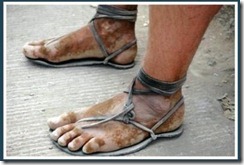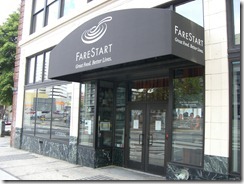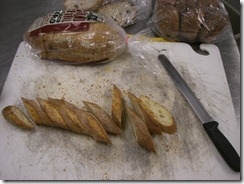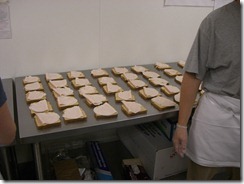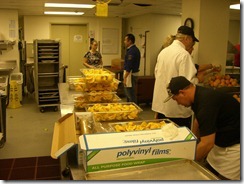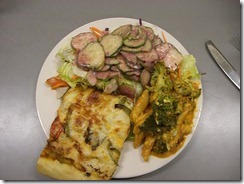1. Micro-drive vs. Macro-drive. The "Micro-drive" concept is bullsh*t on a single-speed. "Micro-drive", a term originally coined and trademarked by the dear departed Maeda Corporation (Suntour), refers to using a system of relatively smaller chainrings and cogs to achieve a similar gear ratio and range as could be achieved previously only with larger chainrings and cogs. "Micro-drive" was made possible at the time by the folks at Suntour by pushing the limits of cog size and making their cassettes with an 11t first position cog. While not a new idea, high-quality heat-treated steels allowed this design to be realized with some degree of success. Matching, lighter, smaller cogs and chainrings and shorter derailleur cages and chains gave the weight freaks something to jump up and down about, and the system actually sorta worked for the rest of us. Shimano copied and the rest is history - say hello to modern multi-speed MTB transmissions.
The reason why it worked and still does is because you could get away with the smaller cogs for higher gears. Let's face it, most of us never spent (or spend) much time in the 11 and 12-tooth cogs so they don't wear all that fast. Furthermore, the time spent in these cogs wasn't ever under full-bore high-throttle. If it ever got so hard to pedal that you needed to stand up, you simply shifted to an easier gear. Had you rode around off-road in a 22x11 cross-gear, without a whole lot of effort you could blow the chain right over the top of those teeth regardless of how new or old your components were. If you didn't realize it, there's only roughly half of the amount of teeth on your cog engaging the chain at any given time. In the case of an 11 tooth cog, that's only 5 or 6 teeth at any given time! Unless your thighs are as big around as a Surly(TM) carpenter pencil, you will be able to make any low-gear transmission required for general one-speed off-road riding skip AT WILL, using an 11 tooth cog...
... and its not so different for a 16 tooth cog, probably the smallest rear cog you might have on your one-speed ride. Considering that you don't shift, you'll be giving EIGHT teeth the full wrath of your wide load up the harshest vertical climbs you choose to attack. What my long-winded explanation is getting at is that more teeth are better when it comes to an off-road one-speed drivetrain. One tooth makes a huge difference out back with regards to preventing skippage. Wear life, too, is improved with more teeth. Since you never leave that gear, every mile you spin is on the same few teeth. Your drivetrain will last longer and will skip less and will launch the chain fewer times if you use larger cogs and chainrings.
I recommend that you pick a big cog out back (18 teeth or larger) and experiment to find a gear ratio you like by varying your chainring sizes up front. The weight penalty here is practically non-existent; there is no benefit whatsoever to using a "Micro-drive" drivetrain on your one-speed off-road bike. Don't do it! It's dumb and you're gonna hurt yourself on a steep climb.
If you have a Singleator(TM): Keeping in mind everything written above, don't you think it's better to run your Singleator(TM) in the �pushing-up� position as opposed to the 'pulling down' position? After all, by pushing the chain up, towards the freewheel, you increase the number of teeth engaging the freewheel for that given gear ratio. Unfortunately, this isn't always possible due to interference with the chainstays, but it is ideal. By the same token, it should now be obvious that since the Singleator(TM) does actually pull the chain away from the freewheel in the 'pulling down' position that you want to minimize this as much as possible. Follow the instructions! Take out as many links as possible! Unlike a derailleur, the Singleator(TM) only has one pulley and wasn't designed to take up any more chain slack than absolutely necessary. And, in situations where you've "Micro-driven" your drivetrain, the 'pull-down' position may never allow you have a sufficient number of teeth engaging the chain for your particular application, weight, or riding style. If you encounter a situation where you've taken out as many links as possible yet the Singleator(TM) still pulls the chain away from the freewheel far enough to cause skippage ("worst case scenario"), change your gear! Get a bigger cog! Get a bigger chainring! Try one tooth smaller on the chainring and take out another link! Re-arrange it, brahh!! You can do it! This worst-case scenario happens very rarely, but enough times to write this, so I hope I'm helping someone. Finish this article before you scramble for the chain-breaker, though...
2. Chainline. Chainline refers to the alignment of the front chainring and the rear cog. Chainline is important on all bicycle drivetrains but especially so on a one-speed. A perfect chainline is one in which the chainring and rear cog are in perfect alignment with each other and the chain takes a perfectly straight path from the chainring to the cog. Anything less than damn close on a one-speed will result in premature drivetrain wear and frequent chain launching. Chain line can be fine-tuned by re-spacing your hub, adding or deleting freewheel spacers or cassette spacers, changing cranks, changing b.b. spindle lengths or shimming bottom brackets, using spacers between the crank spider and chainrings, and whatever else you can think of to get your ring and cog to line up nicely. Your drivetrain will be quieter, too.
If you have a Singleator(TM): Make sure the adjustable pulley is aligned perfectly in your chain line. If it is slightly off it will make noise and wear out the pulley quickly. If it is way off, you can and will tear the Singleator(TM) and/or derailleur hanger off the bike. Do it right and enjoy.
3. Chain tension - how to do it right. If your chain is too tight, it will wear too quickly, it will side-load your freewheel or cassette body causing the pawls inside to skip, and it will require more energy to pedal. If your chain is too loose, it will throw itself off on the downhills and skip over the top of the cog and/or chainring on the steep uphills. You may have noticed when trying to get your chain tension dialed in correctly that the chain is tight in some spots and loose in others. This is normal(sic). Chainrings, freewheels, cassette bodies and crankarms bend, warp and deform to a certain degree with use, and generally aren't perfectly round to begin with. I like to adjust my chain so that is tight enough so that it almost wants to stop the cranks from freewheeling backwards when it is at its tightest spot. That's kind of hard to explain clearly but suffice to say you won't have any catastrophic problems related to chain tension if you can keep the tension somewhere between 'so loose the chain is flopping around on the downhills' and 'so tight you can feel resistance when you pedal backwards.' For those of you with bolt-on hubs, greasing the axle nuts or bolts will help keep unwanted wheel movement to a minimum while you're trying to get your tension set just right. Tightening left and right bolts a little at a time helps, too. Good luck.
If you have a Singleator(TM): If you're running a Singleator(TM) on a bike with vertical dropouts, its sole purpose is to provide adequate chain tension and keep it on the cogs where its supposed to be. Whether you have selected the 'pushing up' position or the 'pulling down' position, read and re-read the instructions to determine you have the correct spring installed, then CRANK IT UP! Don't be shy! If you crank it the wrong way with the wrong spring installed you will ruin your Singleator(TM), though, so be careful. Certainly our spring has its limits, and you almost certainly won't ever be able to get the same amount of chain tension with a Singleator(TM) as you will with a dedicated, horizontal-dropped single-speed, but you can definitely get the chain really nice and safely tight with a Singleator(TM).
4. 1/2x1/8" chains vs. 1/2x3/32" chains. 1/2x1/8" chains suck. Run whatever you want, but bigger isn't better here. Yeah, they're wider, but according to manufacturer-supplied data, they're not stronger and they are definitely not of better quality. Multi-speed drivetrains is where the bucks are at, and chains that work on such drivetrains are where the manufacturers of chains showcase their innovations and developments in quality. The rollers are better, the plates are better, the pins are stronger, and the construction method (riveting procedure) is better on all multi-speed 3/32" chains. I guess if you grind your chainring and chain down the handrail every night at the local pub, a bigger 1/2x1/8 " chain will last longer, but most of us don't and it won't.
If you have a Singleator(TM): Dammit, don't use a 1/2x1/8" chain!!! Otherwise, you'll tear the Singleator(TM) off the bike, among other things, guaranteed. Such gross failure to follow instructions and subsequent damage is not covered under our "we love almost everybody" warranty policy.
5. Shifting-enhanced cogs vs. Normal cogs. Shifting-enhanced cogs, typically Shimano Hyperglide(TM) or Interglide(TM) cogs, refer to rear cogs that have been machined, stamped, pressed or otherwise manipulated to allow a chain to enter and exit easily for clean, smooth shifts on a 5- through 9-speed cluster of cogs. They work pretty good on multi-speed bikes and equally as well on one-speed bikes. Avoid using them on your single! When you put the power down, they'll shift all right-- and you'll be visiting the dentist. Get a dedicated one-speed hub and use a threaded BMX freewheel or use a Shimano DX(TM) BMX cog on your multi-speed cassette hub – they're thick, flex-free and don't have nice exit ramps stamped in 'em. Trust me on this one!!!
6. Hey, REPLACE YOUR PARTS OFTEN! You will have to. Let's say the average dude spends most of their time in 5 or 6 different gears (out of 27, sheesh!) on any given multi-speed bike ride. You spend all your time in one gear. And you're wrenching the snot out of those drivetrain parts in a way they weren't designed for. Your parts will last 1/5 or 1/6th as long as the average dudes'. Ever wonder why you can't get more than 3 months out of a freewheel before its starts skipping on you? First off, they aren't sealed properly, contaminants get into the pawls and impede the motion necessary to engage the teeth. Furthermore, the freewheel gets twisted and warped under all of your torque, making it more difficult for the pawls inside the freewheel to find their teeth on a regular, reliable basis. Pick up a beat, old freewheel, hold the center and spin the outside - you will see what I mean. BMX freewheels and even mountain-bike cassette bodies were never designed for the sort of repetitive, high-torque abuse that one-speeding wreaks on drivetrain parts. Until someone makes a bomb-proof freewheel or cassette hub (King? $$$), get used to replacing these parts often!
7. Hey, USE NEW PARTS TOGETHER!!! Just like on multi-speed drivetrains, used cogs and rings don't like new chains and vice-versa. If you mix 'n match new and old drivetrain parts, particularly cogs and chains, I hope its on your urban luxo-cruiser. Otherwise, always replace cog, chain, and freewheel together for best results. If you replace your chains a lot you can get a lot more life out of your cog and ring, but especially on a single, if you ride technical stuff and up big, steep hills that almost stop you in your tracks, you're pushing your equipment to the absolute limit. Don't believe me? Ask a friend of similar weight and strength to you to ride their multi-speed 25 times hard with a new chain and measure the amount of stretch from the center of one pin to the center of another pin 15-or-so links away. Every link is supposed to be exactly 1" long from pin center-to-pin center. It stretches a lot. And fast. Do the same thing with your single-speed -- new chain, 25 hard offroad rides. You won't believe how much more the chain stretches! By replacing cog, chain and ring together, you ensure that the teeth and chain wear together to ensure a good, strong mesh that won't skip under load. By mixing new and old, you won't get the symbiotic (ulp?!) wear patterns that allow tooth and chain to mesh together properly. You will get funky 'ticks' and 'pops' and skipping under load. This is age-old wisdom here.
8. Frame flex. Your one-speed mountain bike or cross bike has probably been designed to be at least reasonably light; even Surly folk don't enjoy riding 30 lb. bikes up hills. That means you have a light frame that has thin, light chain and seat stays that are anywhere from 16-20" long. Every time you push 'n pull on the pedals, the bottom bracket swings back and forth and the long and skinny stays get pulled toward the drive side of the bike. The whole machine is gettin' twisted by your upper and lower body, especially so on the tough climbs. To a certain degree this flex is desirable and produces a comfortable ride, but any flex at all in a drivetrain system creates deviations that cause skippage, premature wear and, depending on your girth, chain launching. This is not a factor to be ignored! The best way to deal with drivetrain deviations from flex is to make sure all other factors are in order. Certainly a 3.5 lb. cro-moly frame is not the best choice for a one-speed, and if you're in this boat, I hope you weigh under 150lbs. Otherwise, by making sure your chainline is perfect, your rear cog is big, you're geared low enough, your drivetrain is in good shape and all components are wearing together, and your chain is tensioned and lubed properly, you can minimize any potential problems frame flexing will have on drivetrain skipping, chain launching and premature wear.
9. Gear lower. I know all you guys and gals out there are gorillas and want desperately to outdo you pals mentally, socially, physically, etc. on rides, but from a functional standpoint lower gears are better on a one-speed off-road drivetrain. I suppose if you're a member of the go-fast club you have to run a big gear, so you HRM-types can skip this part. But if you're more concerned with your ability to ride and clean the tight stuff, you'll be doing your style a favor and you'll be sparing your drivetrain a small measure of unnecessary abuse by sticking with low(er) gears. Yes, you do have to "spin" more on the flats, subjecting drivetrain parts to more cycles and more wear, but by not having to herniate yourself up the climbs you will be reducing the amount of shock, distortion and potential for catastrophic skippage or breakage of your drivetrain components. Not to mention your unmentionables.
10. Lube your chain. C'mon.
11. Lube your freewheel. There's bearings and moving parts inside. Use oil, not grease. C'mon.
12. Other problems, er, human error. Before you curse your one-speed or the Singleator(TM) and the folks who made it, read and absorb the guidelines above. While any competent, professional mechanic should be able to diagnose any specific problem you are having with your drivetrain, if you're going solo, it might be tough for you to pick out which exactly of the above is giving you fits. If you have indeed digested and tried all of the above but still can't get your sh*t together, drink a few beers then read it again. Or drop your ride off at a good local shop and pay a little. Or give us a call – we'll give you a little hell, but we like to help, otherwise we wouldn't have written this. Or give up and ride a geared bike -- after all, "there's nothing wrong with that"...
Love, Wakie
The 1x1(TM) gear chart
| 1x1 | 24 | 26 | 28 | 29 | 30 | 31 | 32 | 34 | 36 |
| 16 | 1.50 | 1.63 | 1.75 | 1.81 | 1.88 | 1.94 | 2.00 | 2.13 | 2.25 |
| 17 | 1.41 | 1.53 | 1.65 | 1.71 | 1.76 | 1.82 | 1.88 | 2.00 | 2.12 |
| 18 | 1.34 | 1.45 | 1.56 | 1.61 | 1.66 | 1.72 | 1.78 | 1.89 | 2.00 |
| 20 | 1.20 | 1.30 | 1.40 | 1.45 | 1.50 | 1.55 | 1.60 | 1.70 | 1.80 |
| 22 | 1.09 | 1.18 | 1.27 | 1.32 | 1.36 | 1.41 | 1.45 | 1.55 | 1.64 |
[This was lifted from the Surly web site by me. Because it was so darn good. Gotta give credit where it's due.]

